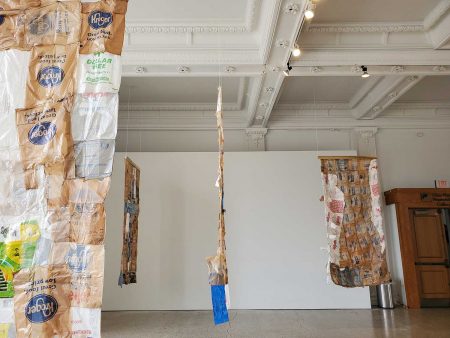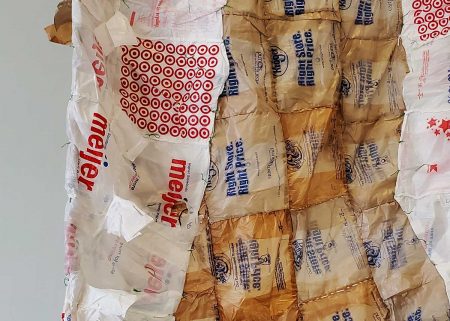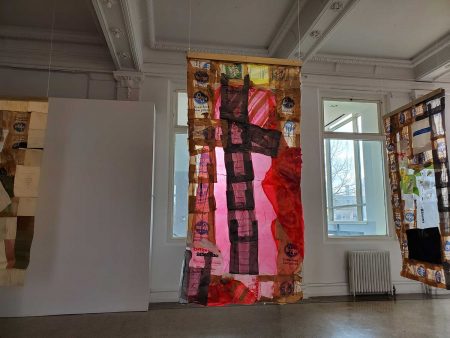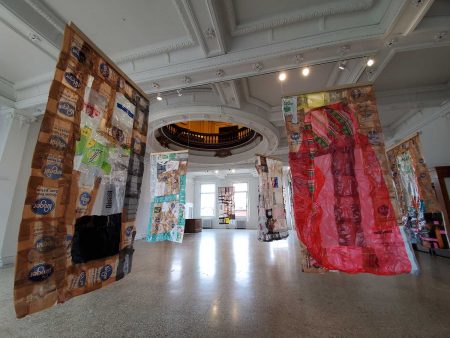It was a drizzly Tuesday afternoon. With long sleeves balled around his hands, Matt Distel opened the front door of The Carnegie. The previous Friday would have been a big night for the Exhibitions Director, but along with art and cultural events across the country, the opening reception for four new shows was cancelled due to the spread of COVID-19. In the span of a few days, the phrases “social distancing” and “flatten the curve” had infected the vernacular as the reality of the global pandemic sank in.
We awkwardly kept our distance from one another as we moved into the Ohio National Financial Services Gallery where works by the late Kentucky artist Jessie Dunahoo hung like shopping bag tapestries throughout the ornate rotunda. As we walked among the works quilted from discarded plastic bags, it occurred to me that this exhibition might never open to the public. Meaning I might be one of very few people with the privilege of seeing it in person — an irony, given that the artist, who died in 2017 at the age of 84, was deaf and blind.
Jessie Dunahoo was born without hearing. Raised on a farm in rural Kentucky in the 1930s and 40s, he lost his sight at a young age. According to a biography supplied by Institute 193 (the Lexington-based organization that co-curated this exhibition) Dunahoo spent his childhood exploring the outdoors by touch, navigating the world with the aid of a 3-D map he created with a network of intersecting ropes and lines hung from fences and trees. He continued this practice throughout his life, constructing complex environments sewn from sacks, fabric, and other found materials.
The work in this exhibition is a sampling of an immense body of quilts made mostly from layers of reclaimed plastic bags. They hang from the ceiling, mounted with wooden bars, and can be viewed from all sides. Walking among these works is something like a religious experience. It takes time for the variety of pattern and texture to sink in. With sunlight slanting through the windows, differing thicknesses and transparencies are evident.
The quilts are samely sized to the dimensions of Dunahoo’s workbench, and they certainly connect to Kentucky’s long and rich history of quilting culture. The artistry is apparent in the many ways he has drawn attention to the edges. In some, plastic handles twist into pigtails dangling at regular intervals. In others, the edges are a thickened braid. It’s worth contemplating that the visual compositions of these works are incidental: To Dunahoo, aesthetic decisions would have been dictated by tactile experience. Thus, a checkered patterning of striped and flat blue fabric would indicate subtle differences in texture. That they emit varying wavelengths on the visible spectrum of light is irrelevant to the artist’s intent. That Kroger bags and Target bags and deflated EarthAware air pouches tend to be grouped together reflects subtle variances in material that might otherwise go unnoticed but for imagining how Dunahoo, in his own sensory world, related to these objects[1].
We vision-oriented creatures might agree that a Target bag is white with a grid of red bullseyes; that it is lightweight and shaped in the form of a pouch that can carry smaller objects; that if overloaded it might cut into knuckles as we carry it in from our vehicle. Wrapped around a toddler’s head, it is a tragedy. Spiraling around an empty parking lot and filmed with a VHS camcorder, it is beautiful.[2] We know it is made from petroleum-derived polyethylene and, once discarded, it will take between 500 and 1,000 years to decompose. These are all true, but they don’t tell us what a plastic bag is. The more exhaustively we describe a thing, the further it recedes — and the more apparently unimportant our particular mode of access. Philosopher Graham Harman calls this withdrawal, and it is the basis of Object-Oriented Ontology (OOO). “Things withdraw from presence into their dark subterranean reality,”[3] he writes. According to OOO, the thing that we call a plastic bag exists in its own right, independent of whatever qualities we ascribe it, and we have no business privileging human subjectivity, to say nothing of the able-bodied variant. An ethics emerges that de-centers the human experience (of which all variant modes are equal), opening up an infinity of ways things might relate to — and withdraw from — one another. This tension of relation and withdrawal is at the core of my own aesthetic response to this work.
As Dunahoo’s quilts withdraw, relations unfold. One glows red in the window’s light. Another hangs heavily. Another lightly flutters. What is the relationship between these quilted bags to the grand old structure in which they hang? Formerly a public library, it was funded by Andrew Carnegie for the purpose of posthumously reorienting his reputation as a robber-baron capitalist to one of a benevolent philanthropist. This library would have organized books by Dewey Decimal Classification (DDC). The DDC itself is interesting in that it aspires to orient the world to a rigid system of knowledge relationships, none of which are ideologically neutral. The DDC has been rightly criticized for its tendency to privilege the Anglo-American worldview[4]. By insisting the world of knowledge orient to this schema, it funnels power to that worldview. By contrast, Dunahoo’s tactile maps are a tool for orienting oneself to the world on whatever terms the world presents itself.
With Distel’s permission, I closed my eyes and touched one of the quilts. I felt a surprising softness and heard a faint crinkle. I didn’t feel oriented, but I felt a vicarious connection to some realm of intimacy. A human touch.
A recent article in The Atlantic by science journalist Ed Yong posits: “After infections begin ebbing, a secondary pandemic of mental-health problems will follow. At a moment of profound dread and uncertainty, people are being cut off from soothing human contact. Hugs, handshakes, and other social rituals are now tinged with danger.”[5] When this crisis is through, the world will be profoundly changed. Our social relationships are being remapped as we speak. And when we emerge from our social distancing quarantines, how will we relate to each other? We’ll need some way of orienting ourselves. We might have a thing or two to learn from this work by an artist who understood the world through touch.
–Steve Kemple
[1] In just about any other context, I might have balked at the aestheticization of refuse. While friendly and heartwarming, this is an alarming trend in visual art that ultimately serves to absolve those entities responsible for the decimation of our ecosystem. However, Dunahoo’s use of reclaimed material sits outside of this trend, and thus is not fully deserving of this criticism.
[2] Relevant clip from the 1999 feature film American Beauty: https://youtu.be/tB0th8vNLxo
[3] Graham Harman, Tool Being: Heidegger and the Metaphysics of Objects. (Open Court, 2002). pg 2.
[4] Although the DDC is regularly revised and has corrected a few of its more egregious errors, many remain. See Holie C. White, “Decolonizing the Ways Libraries Organize” for a brief overview.
[5] Ed Yong. “How The Pandemic Will End”. The Atlantic. 25 March 2020.





